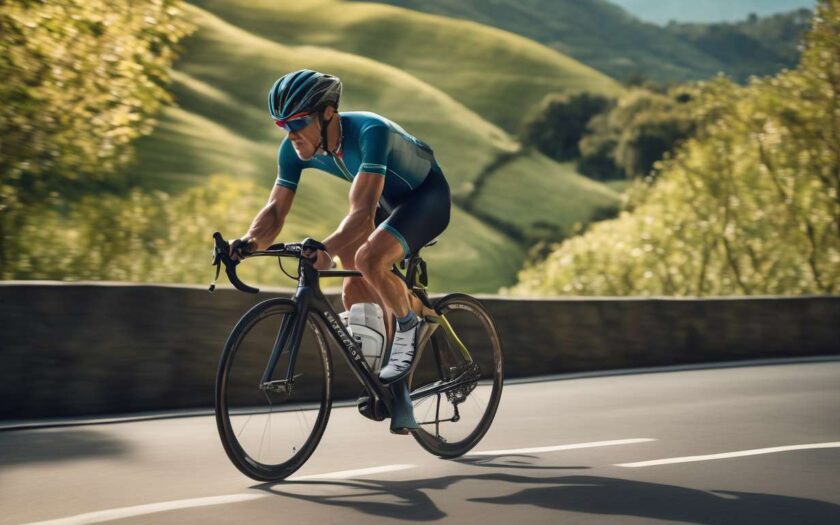As cycling enthusiasts, we know that understanding a cyclist’s form is crucial to both improving performance and enjoying the ride. Whether we’re seasoned riders or just starting out, deciphering the nuances of cycling form can seem like an art reserved for the pros. However, with the right guidance, we can all learn to read the subtle cues that indicate our strengths, weaknesses, and areas for improvement.
In this article, we’ll explore the key aspects of cycling form, breaking down complex concepts into practical tips that we can apply on our rides. From analyzing cadence and pedal stroke to recognizing the impact of fatigue, we’ll uncover the secrets that can transform our cycling experience.
Key Aspects to Consider:
-
Cadence:
- Understand your optimal pedaling speed.
- Practice maintaining a consistent cadence.
-
Pedal Stroke:
- Focus on smooth, circular motions.
- Aim for efficiency and power in each stroke.
-
Posture and Position:
- Ensure correct bike fit to prevent injury.
- Maintain a relaxed upper body and engage core muscles.
-
Breathing:
- Develop rhythmic breathing patterns to maximize oxygen intake.
- Practice deep breathing to enhance endurance.
-
Recognizing Fatigue:
- Identify signs of muscle fatigue and adjust intensity accordingly.
- Incorporate rest and recovery into your training routine.
Together, we’ll embark on a journey to not only enhance our own skills but also to gain a deeper appreciation for the sport we love. Let’s dive in and unlock the mysteries of cycling form.
Cadence Mastery
Mastering cadence in cycling requires finding the optimal balance between speed and effort for improved performance. Cadence isn’t just about spinning pedals faster; it’s about harmonizing rhythm to maintain an efficient pace.
By adjusting cadence, we:
- Conserve energy
- Enhance endurance
- Foster a sense of unity within the cycling community
Posture plays a crucial role in achieving cadence mastery. Maintaining a relaxed and aerodynamic position:
- Reduces drag
- Allows legs to spin freely
- Boosts efficiency
- Aids in quicker recovery during rides
Recovery is just as important as the ride itself. After pushing limits, embracing rest allows muscles to heal and adapt.
By focusing on:
- Cadence
- Posture
- Recovery
We empower ourselves to reach new heights in our cycling journey.
Perfecting Pedal Stroke
To perfect our pedal stroke, we need to focus on smooth, consistent motion that maximizes power and efficiency.
Cadence plays a pivotal role in maintaining rhythm:
- Aim for a cadence that feels natural and sustainable.
- Connect with your bike and fellow cyclists.
- Find the sweet spot where your legs spin effortlessly, reducing fatigue over long rides.
Posture is crucial for enhancing pedal stroke:
- Keep your back straight and core engaged.
- Transfer energy more effectively.
- Maintain stability and balance.
- Boost power and foster a sense of unity within your cycling community.
Finally, remember the importance of recovery:
- After exerting yourself, allow your muscles to recover.
- Enable muscle growth and strengthening.
- Balance effort and recovery to stay energized and ready for the next ride.
This approach ensures you glide with ease and grace, both individually and collectively with fellow cyclists.
Optimal Posture Techniques
To achieve optimal posture on the bike, let’s focus on aligning our bodies for maximum efficiency and comfort. As a community of cycling enthusiasts, we know that good posture isn’t just about looking sleek; it’s about feeling connected to our bikes and ensuring a smooth ride.
Key Aspects of Optimal Posture:
- Ensure your back is straight.
- Keep shoulders relaxed.
- Slightly bend your elbows.
This posture helps us maintain a steady cadence, which is crucial for both endurance and speed.
Benefits of Proper Posture:
-
Core Engagement:
- Distributes the workload evenly.
- Prevents fatigue.
- Promotes effective recovery.
-
Consistent Cadence:
- Enhances muscle efficiency.
- Reduces strain and risk of injury.
It’s this harmony between posture and cadence that keeps us riding strong together.
Ultimately, good posture is our foundation for a successful ride. By focusing on these techniques, we not only improve individually but also strengthen our shared passion for cycling.
Let’s ride with purpose and unity!
Breathing for Performance
To maximize our cycling performance, let’s focus on mastering breathing techniques that enhance endurance and efficiency. By coordinating our breath with our cadence, we create a rhythm that supports sustained energy output. Imagine us pedaling together, each breath harmonizing with the rotations of our wheels. This synchronicity not only boosts our stamina but fosters a shared sense of unity on the road.
Maintaining proper posture is crucial for optimal breathing. By keeping our chest open and shoulders relaxed, we allow our lungs to expand fully, drawing in more oxygen. This improved oxygen intake translates to better muscle performance and quicker recovery times, so we can keep pushing forward as a team.
In moments when we need to recover, deep diaphragmatic breathing helps us return to a steady state. Let’s take those moments to reset and refocus, ensuring we’re ready for the next challenge.
Together, through mindful breathing, we can conquer any ride with confidence and camaraderie.
Understanding Muscle Fatigue
As cyclists, we often face muscle fatigue that challenges our endurance and requires strategic management to maintain peak performance. It’s crucial for us to understand how our bodies respond to fatigue and adapt our techniques accordingly.
One key aspect is maintaining a consistent cadence. By doing so, we ensure that our muscles work efficiently, balancing effort and preserving energy for the long haul.
Our posture plays a vital role too. When we maintain proper alignment, we reduce unnecessary strain on our muscles, allowing for smoother rides and less fatigue build-up. A strong core supports good posture, which in turn helps us manage fatigue better.
We must listen to our bodies and recognize early signs of fatigue. This awareness allows us to make real-time adjustments, such as:
- Shifting gears
- Altering cadence
- Taking short breaks
By understanding our limits and employing strategic pacing, we can enhance our rides and enjoy a stronger sense of community within the cycling world.
Recovery and Regeneration Tips
To bounce back stronger after intense rides, we should prioritize effective recovery and regeneration strategies.
Cadence During Cool-Down Rides:
- Focus on maintaining a steady, comfortable rhythm.
- Helps flush out lactic acid, aiding muscle recovery.
Posture Off the Bike:
- Pay attention to proper alignment while sitting or standing.
- Prevents unnecessary strain and promotes quicker healing.
Active Recovery Exercises:
- Integrate activities like yoga or gentle stretching.
- Enhances flexibility and reduces stiffness.
- Fosters a sense of unity among our cycling community.
Hydration and Nutrition:
- Replenish lost fluids.
- Consume balanced meals with protein and carbs.
- Ensures readiness for our next adventure together.
Importance of Rest:
- Prioritize sleep and take regular rest days.
- Allows our bodies to repair and strengthen.
- Reinforces our shared desire to improve.
Together, we can embrace these recovery tips and continue pushing our limits.
Monitoring Heart Rate Zones
Understanding our heart rate zones is essential for optimizing training and enhancing performance. By monitoring these zones, we ensure our efforts align with our training goals, whether that’s building endurance or increasing speed.
Key Factors to Consider:
- Cadence: Influences how efficiently we stay within specific zones.
- Posture: Helps maintain comfort and effectiveness on longer rides.
High-Intensity Zones:
When we’re pushing hard in higher heart rate zones, our bodies are working to their limits. It’s crucial to know how long we can sustain these efforts before shifting into a zone that promotes recovery.
Tools for Monitoring:
Using heart rate monitors, we can:
- Track our progress.
- Make necessary adjustments.
- Avoid overtraining.
Goal:
It’s about finding that balance and staying connected with our bodies. By understanding and using our heart rate zones, we ride smarter together, supporting each other in achieving our cycling goals.
Analyzing Power Output
To maximize our cycling performance, we need to analyze power output, which provides a direct measure of the work we’re doing on the bike.
By understanding our power output, we can tailor our training to meet specific goals, whether it’s building endurance or improving speed.
We should focus on our cadence, as maintaining an optimal pedal stroke can enhance efficiency. Too fast or too slow, and we might:
- Waste energy
- Strain our muscles
- Impact our power output
Our posture on the bike also plays a crucial role. A proper posture:
- Reduces drag
- Ensures maximum power transfer from our legs to the pedals
Let’s not forget recovery, essential for sustaining power over longer rides. By incorporating strategic recovery periods, we allow our muscles to:
- Repair
- Prevent fatigue
- Maintain consistent power output
By focusing on these aspects—cadence, posture, and recovery—we create a supportive community that encourages each of us to reach our cycling potential together.
How does mental focus impact cycling performance and form?
Maintaining mental focus is crucial in cycling. It significantly affects both our performance and form.
Benefits of Staying Mentally Sharp:
- Enables us to push through challenges.
- Helps maintain a steady pace.
- Enhances endurance during long rides.
- Aids in maintaining proper technique.
Impact of Mindset:
- Tapping into full potential.
- Achieving cycling goals with confidence and determination.
By prioritizing mental focus, cyclists can enhance their overall experience and performance on the road.
What role does nutrition play in maintaining cycling form during long rides?
Nutrition is crucial for maintaining a strong cycling form during long rides.
We need fuel to sustain our energy levels and perform at our best. Eating balanced meals can help with this, as they provide the necessary nutrients for both energy and recovery.
A balanced meal should include:
- Carbohydrates
- Protein
- Healthy fats
Hydration is also key to prevent fatigue and cramps. Ensuring adequate fluid intake before, during, and after rides is essential to maintaining performance and overall health.
By paying attention to what we eat and drink, we can ensure we have the energy needed to tackle those challenging rides.
How can different types of terrain affect a cyclist’s form?
Different types of terrain can greatly impact a cyclist’s form.
-
Uphill Sections:
- Require more power output.
- Can cause fatigue, affecting form.
-
Downhill Stretches:
- Demand good bike handling skills.
- Necessary to maintain form and control speed.
-
Flat Roads:
- Allow for a more consistent pedaling rhythm.
- Aid in maintaining form.
Adapting to varying terrains is crucial for maintaining optimal cycling form and performance. It’s all about adjusting and finding our groove to conquer any type of terrain.
Conclusion
To effectively decode cycling form, focus on the following key elements:
-
Master Cadence:
- Work on maintaining a consistent pedal stroke rate.
- Aim for an optimal cadence that suits your riding style and terrain.
-
Refine Your Pedal Stroke:
- Practice smooth and efficient pedal movements.
- Ensure equal power distribution throughout the pedal cycle.
-
Maintain Optimal Posture:
- Keep a relaxed yet firm grip on the handlebars.
- Align your back and shoulders properly to reduce strain.
-
Utilize Proper Breathing Techniques:
- Inhale deeply and exhale fully to maximize oxygen intake.
- Synchronize your breathing with your pedal rhythm.
-
Recognize Muscle Fatigue:
- Be aware of signs of overuse and avoid pushing beyond your limits.
- Adjust your pace to prevent injury and sustain performance.
-
Prioritize Recovery:
- Incorporate rest days into your training schedule.
- Use stretching and foam rolling to aid muscle recovery.
-
Monitor Heart Rate Zones:
- Track your heart rate to stay within your target zones.
- Adjust intensity levels based on your heart rate feedback.
-
Analyze Power Output:
- Use power meters to gauge your effort and efficiency.
- Make data-driven adjustments to your training regimen.
By implementing these practices, you’ll enhance your cycling performance and efficiency.
Keep pushing yourself, stay mindful of your form, and enjoy the ride to reach your cycling goals.

